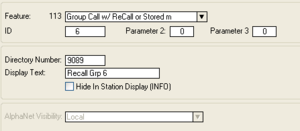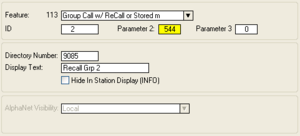Recall
From Zenitel Wiki
The Recall function let you record a message from a station, and then dispatch the recorded message as a Group Call. The function is used to prevent feedback problems when making Group Calls. The recorded message is temporary stored. It is deleted when the groupcall is finished. The maximum duration of a single recall message is limited to 3 minutes. The total system storage capacity for recall is approx. 40 minutes.
Directory numbers
Default directory numbers for "recall" broadcast:
- 9084: Recall to group 1 (all)
- 9085-9088: Recall to groups 2 - 5
- 9101: Recall to global group 1 (for AlphaNet)
More recall numbers can be added from AlphaPro if required. In the Directory & Features window, select Insert and select Feature 113 and ID = local group number. Enter any free directory number and an appropriate display text.
The recall function can also be activated via a two-step operation, using the feature code 765. Dial 765 + group number.
User interface
To initiate a group call using the recall function:
- Dial the recall number (e.g. 9084, or 765+84)
- Press M-key, record message
- Release M-key, listen to the recording
- Press 8 to dispatch the message, M to do a new recording, 7 to repeat the message or C to cancel
Using the recall function from a telephone:
- Dial the recall number (e.g. 9084, or 765+84)
- Press the *-button, record message
- Press the #-button to stop the recording and listen to the message
- Press 8 to dispatch the message, * to do a new recording, 7 to repeat the message or hang up to cancel
Optional settings
The recall user interface and the recall attributes can be altered by modifying parameter 2 of the recall directory number. By default this parameter is 0.
Options:
| Value parameter 2 | Function |
|---|---|
| 1 | After the playback to group ends, the groupcall and the initiator station proceed to normal Group Call mode, and can use M-key to talk into the group |
| 2 | If the initiator station disconnect during the playback to group, the message is terminated immediately |
| 8 | The initiator station will not listen to the playback to the group |
| 32 | The message is dispatched when pressing C or hanging up (no need to confirm by '8') |
| 128 | There will be no gong before the groupcall |
| 256 | The group is a global groupcall |
| 512 | There is no need to use M-key during the recording |
Different options can be combined.
Example: If parameter 2 = 544 (i.e. 512+32) there will be no need to press M-key to record, and the message is dispatched when pressing the C-key:
- Dial the recall number (e.g. 9084)
- Record message (no M-key)
- Press C or hang up to dispatch the message
- Digit '7' (or '#') can be used to stop the recording and listen to the message. Press M-key (or '*') to restart a recording
- Digit '0' will delete the recording and cancel the operation
This option can be useful when using the recall function from telephones.
For two-step recall (i.e. 765 + group), the attributes are set in parameter 1 (ID) of the 765 feature code.
Simultanous recall operations
Simultanous recall operations are handled in the same way as for regular groupcalls:
- Several recall operations can be active at the same time as long as there is no overlap in members of the simultaneous groups. If there is an overlap, the second recall operation will meet busy signal. However, there is a "Max Missing Members" setting per group in AlphaPro, which will let the second group call go through if the overlap is less than the number of stations specified.
- The possibility to have simultaneous group calls can be disabled in AlphaPro, Exchnage & System > System > Calls and Options Simultanous Group Calls. A new group call will then meet a busy signal if the ongoing call has the same or higher priority. An ongoing group call will be canceled by a new group call with higher priority.
Hardware and software requiements
Hardware: The recall function can be used on all AMC-IP hardware versions (red or black PCB).
Software: Recall is available from AMC software version 11
License: Recall requires an Audio Messaging license.


